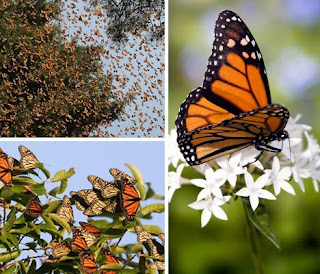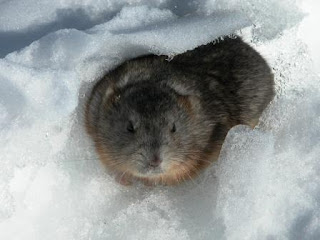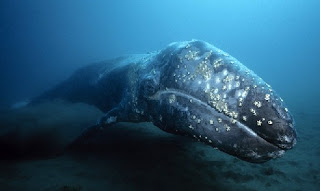Animal migrations are some of the most moving (literally) phenomena Mother Nature has to offer, these is amazing animal migrations in the world :
1. Monarch Butterflies The mass migration of Monarch Butterflies is arguably the longest – both in distance and time – of any insect species. Conducted over a number of seasons and generations, perhaps the most amazing thing about the Monarch migration is that their overwintering refuge in central Mexico’s Oyamel Fir forests wasn’t discovered until 1975. Will the majestic Monarchs be able to continue their epic migrations in the coming years? They face a range of difficulties, some but not all the result of human activity. Illegal logging, land clearing and simple population pressure will likely increase but besides these, regular El Nino events such as the one in 2009-2010 soak their winter refuges with rain, sleet and snow.
The mass migration of Monarch Butterflies is arguably the longest – both in distance and time – of any insect species. Conducted over a number of seasons and generations, perhaps the most amazing thing about the Monarch migration is that their overwintering refuge in central Mexico’s Oyamel Fir forests wasn’t discovered until 1975. Will the majestic Monarchs be able to continue their epic migrations in the coming years? They face a range of difficulties, some but not all the result of human activity. Illegal logging, land clearing and simple population pressure will likely increase but besides these, regular El Nino events such as the one in 2009-2010 soak their winter refuges with rain, sleet and snow.
2. The Great Wildebeest Migration
 The annual migration of over 1 million African Wildebeest and Zebras has been well documented by filmmakers and wildlife documentary producers for decades. Every February in the Ngorongoro area of Tanzania’s southern Serengeti plains, the “Great Wildebeest Migration” begins. The exact starting date depends on the progress of the calving season during which around 500,000 calves are born, but by early March up to a half million zebra, nearly 2 million wildebeest and around 100,000 other grazing animals are on the move, headed towards the fertile plains and woodlands of the western Serengeti across the border in Kenya’s Masai Mara region.The final obstacle for the Serengeti’s thundering herd is also the most challenging: the Mara river. Animals already weakened by weeks of travel through dry and barren savannah offering little food or water must now run the gamut of flood-swollen, rushing waters and swarms of hungry crocodiles. Around 250,000 wildebeest will die during the course of their 1,800-mile migration but the herds have proved to be remarkably resilient.
The annual migration of over 1 million African Wildebeest and Zebras has been well documented by filmmakers and wildlife documentary producers for decades. Every February in the Ngorongoro area of Tanzania’s southern Serengeti plains, the “Great Wildebeest Migration” begins. The exact starting date depends on the progress of the calving season during which around 500,000 calves are born, but by early March up to a half million zebra, nearly 2 million wildebeest and around 100,000 other grazing animals are on the move, headed towards the fertile plains and woodlands of the western Serengeti across the border in Kenya’s Masai Mara region.The final obstacle for the Serengeti’s thundering herd is also the most challenging: the Mara river. Animals already weakened by weeks of travel through dry and barren savannah offering little food or water must now run the gamut of flood-swollen, rushing waters and swarms of hungry crocodiles. Around 250,000 wildebeest will die during the course of their 1,800-mile migration but the herds have proved to be remarkably resilient.
3. Legend of the Lemmings
4. Gray Whales migrations
Gray Whales are a popular sightseeing attraction in and around Baja California but few are aware of the creatures’ long distance migration. In fact, Gray Whales have the longest migration route of any mammal, land or sea.Each year, these medium-sized, mild-mannered cetaceans make a round trip of 10,000-12,000 miles (around 18,000 km) between their winter calving lagoons off southern California and Mexico and their preferred summer feeding grounds around Alaska’s Aleutian Islands and the Bering Strait.Besides providing enjoyment for whale-watchers up and down the California coast, Gray Whales have another claim to fame: the 1988 effort to rescue three whales who overstayed in the arctic and became trapped in sea ice off Point Barrow. The drama was closely followed on American television and the rescue (which cost $5.5 million) entailed the use of Coast Guard helicopters dropping 5-ton concrete pillars to break up the ice and a Soviet icebreaker that helped carve a path from the whales’ shrinking pool of unfrozen water to the open sea.
5. March of the Emperor Penguins
Emperor Penguins aren’t the only species of this iconic antarctic bird that migrate but they are perhaps the most famous, thanks in part to the beautifully filmed chronicle entitled March of the Penguins. These magnificent creatures are highly adapted to the incredibly harsh conditions they live in; even so, breeding during the bone-chilling, pitch black Antarctic winter is a monumental achievement in and of itself. Though the migration of Emperor Penguins to and from their inland nesting grounds may seem short compared to that of other animals in more temperate climes, the journey is fraught with hardships and the margin for error is exceedingly thin.
source : here
Friday, June 25, 2010
5 Amazing Animal Migrations
Labels: Animal Phenomena
Posted by besar at 6:52 PM
Subscribe to:
Post Comments (Atom)


0 comments:
Post a Comment